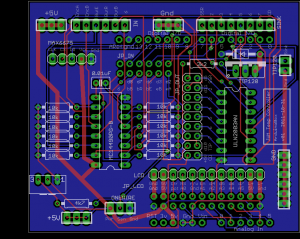Toothbrushing timer
Having to brush someone’s teeth ranks only slightly higher than wiping their butt.
Since one hurdle in brushing one’s teeth seems to come from completing the proper duration, and because I like LED lights, I decided to put together a timer for the kids. Plus, since we’re using their bathroom until ours re-emerges from the renovation rubble, I can use it too.
It’s a string of addressable LEDs from Adafruit, controlled by an Arduino Leonardo. Pushing the button triggers the lights to fill the bar with green, divided into quarters by blue dots. As the timer runs down, the bar turns from green > yellow > red. Then when it’s done, it fills up with blue and fades away.
These are the first videos I was able to grab; neither shows the finish because my iPhone camera likes to lock up:
heatsink
Mounted a few components in the case of ArduinoBox Serial# 2, including the heatsink for the solid-state relay. Should do the trick. This picture also shows the populated circuit board, which only had one small problem in that the terminal blocks on one side are too close to a set of female headers, so I had to replace the terminal blocks with female headers and turn the terminal blocks into a connector. Seems like it will work.
[singlepic id=6719 w=450]
my first circuit board
Just received my circuit board design back from BatchPCB; it only took a couple weeks and looks pretty good to me. For some reason they sent six although I ordered three. I have most of the parts to finish it, thanks to a steady stream of small packages from China recently. eBay rules for cheap electronic parts.
For everyone other than Arron, this is to interface an Arduino microcontroller with the other circuitry and sensors for a temperature controller. It will control a water bath for cooking and eventually the coffee roaster too. And maybe a smoker…
[singlepic id=6717 w=800]
As some background information, here is an image of the various layers that went into the board:
arduino: camera & flash controller
First effort to build a trigger for the camera flash for high-speed photography. When you press the button, it opens the shutter and starts measuring the sound level; if a threshold is exceeded, it fires the flash and then closes the shutter. It could obviously use some work on the lighting, etc., but I’m happy with the single test so far.






